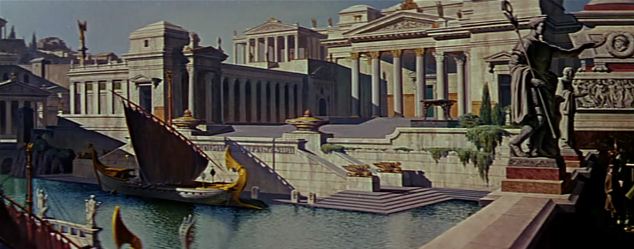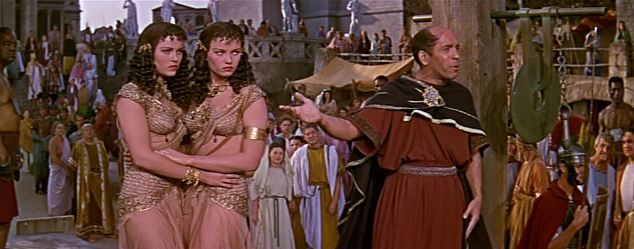Cinema reached such a pitch in the 1950s that innovation became an end in itself. There is something special about the innovations in technology such as Cinemascope. Just seeing these credits roll, you can’t help but imagine yourself back into one of the cinemas and imagine the thrill of seeing everything so large, colourful and wide. The Robe was the first film to use the Cinemascope lens, as designed by the president of 20thCentury Fox, and it was used between 1953, when The Robe was released, to 1967, when superior technologies took over. It was wide, baby, wide.
The anamorphic Cinemascope lenses allowed filmmakers to create an image of up to a 2.66:1 aspect ratio, almost twice as wide as was previously common, and so a Biblical epic like The Robe was a great place to start. Ancient Rome was ripe for the portraying and many great mattes were prepared, as were legions of extras who just look overweight, north American, and often quite bored.
Hindsight allows us to see how unlikely the picture of ancient Rome was however, and the ancient Rome of The Robe was not surprisingly very like 1950s America, with its humour, capitalism and stock characters. The Robe opens with Richard Burton wandering among the slave market, a scene which is pure fantasy, in which slave traders make dumb sales pitches and sassy deals. You can’t flaw the film for this however, as societies always make art that reflect themselves, so why shouldn’t 1950s America be any different.
What is compelling about The Robe, other than watching the young Richard Burton, is the basic story premise, which extracts the Roman soldiers who gamble at the foot of the cross, and makes an entire adventure story out of one of them; it’s a great idea. It was a hard acting challenge for Burton, as he had to play an arrogant young Roman who experiences some kind of madness, or emotional struggle, before his final conversion; and so you see lots of Burton shaking and quaking, raving and wobbling, with his eyes popping as he struggles against the irresistible force of the Christian faith.
You don’t learn a lot about Christianity in The Robe, because Burton’s transformation into a Christian comes about through magic, whereas most Romans who converted would have done so via the powerful theology of Paul, which greatly appealed to those who felt the existing Roman faiths to be over decadent. This decadence is brilliantly portrayed by Jay Robinson, who plays Caligula, and who had in his day the cruellest looking eyes in all of Hollywood. Robinson played in many weird roles in his days, including as Dracula several times, once in the TV movie The Bay City Rollers Meet the Saturday Superstars (1978).
Burton was a great choice for Marcellus in The Robe however, and the camera, fitted with its anamorphic lens, clearly loved him. There is a lot of Richard Burton’s trademark angry shouting in The Robe, and where the script lets him down in terms of character development, he more than makes up for it by looking plain mad, which he does to express his transformation. Although audiences were and still are bound to accept that the Christianity of The Robe is a good thing, especially when set against the horrors of Caligula’s rule, an alternate reading is possible. Burton after all portrays Marcellus Gallio as impetuous, fad following and rather crass at times, and I think this reflects poorly on Christianity, much in the same way that the weak-minded often end up following daft cults. Indeed, people who’ve had nervous breakdowns as Marcellus clearly has, can be very susceptible to idiotic ideas, and it seems there’s an element of that here.
It turned out that CinemaScope lenses were flawed by the fixed anamorphic element, which caused the width-creating effect to drop off as objects approached closer to the camera. Get up close, get strethced and bumpy! The result was that close-ups would overstretch an actor's face, a problem that was referred to as "the mumps". This problem was avoided in The Robe and in early Cinemascope productions by composing wider shots, but as the technology lost its novelty, directors sought freedom from these limitations and sought other methods.
The stand out fact of The Robe has always been for me the fact that it proved Richard Burton’s credentials to the world. He went on to act in many films of course, and generally didn’t vary that much in what he offered, which was an intensity that the camera loved. Burton stares, and he stands still, and he erupts without warning, and all of it is perfectly compelling. He is great in the action scenes, believable in the love scenes, and when he’s holding the film together either in a set piece with others, like at the slave market, he always steals the show.
He was for me and many, somebody we just loved to be with.







